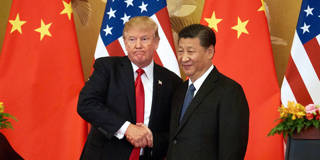China's leaders will attempt to re-stabilize bilateral ties and ease tensions in its non-US relationships. At the same time, they are likely to use the next year to form a deeper judgment about the future of US politics and foreign policy.
NEW YORK – Throughout 2018, much of Asia has been shaken by the new and increasingly unpredictable dynamics in Sino-American relations. One year ago, US President Donald Trump returned from Beijing after his “state-plus” visit, which China hoped had finally laid his anti-Chinese campaign rhetoric to rest. Twelve months later, China and the United States are caught in an unresolved trade war, and Trump’s administration has replaced US “strategic engagement” with China with “strategic competition.”

NEW YORK – Throughout 2018, much of Asia has been shaken by the new and increasingly unpredictable dynamics in Sino-American relations. One year ago, US President Donald Trump returned from Beijing after his “state-plus” visit, which China hoped had finally laid his anti-Chinese campaign rhetoric to rest. Twelve months later, China and the United States are caught in an unresolved trade war, and Trump’s administration has replaced US “strategic engagement” with China with “strategic competition.”